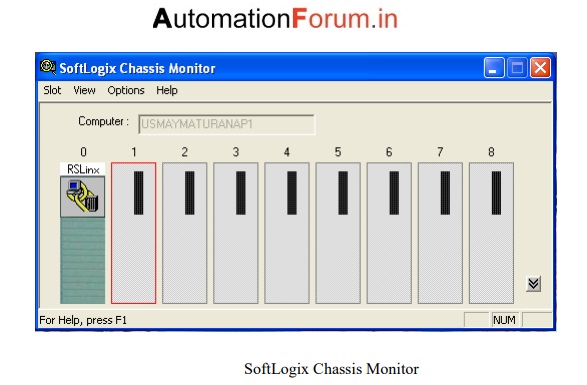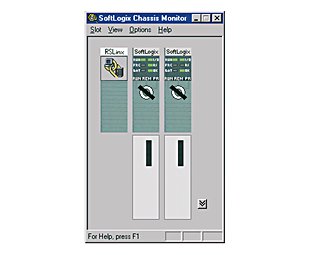Softlogix Chassis Monitor Shadow Of Colossus Pc Download Mar 03, 2017. DOWNLOAD Shadow Of The Colossus ROM (Download Manager) DOWNLOAD Shadow Of The Colossus ROM (Direct) PLAY Shadow Of The Colossus ONLINE. In order to be able to play this game you need an emulator installed. See the full list of available Sony PlayStation 2 emulators for this.

I have an annoying problem. I'm trying to emulate a plc to test an RSView HMI. I had RSLogix Emulate and heard SoftLogix should be better, so i installed SoftLogix. When installing i had to uninstall Emulate because they are incompatible. Now, i can't start SoftLogix because it says: 'Could not determine which modules are present in the chassis.
From the SoftLogix chassis monitor. The chassis monitor shows the 1789-SIM module as a virtual module in the SoftLogix chassis. Anyone use Rockwell's Softlogix? You have to build the rack in the SoftLogix Chassis Monitor and then build the rack in RSLogix to match. SoftLogix Chassis modules must be removed'. How am i going to get out of this? Which can create/monitor/debug/online edit etc. Applications for ControlLogix.
Office 2013 Cracker here. Aborting the application' And, also i can't uninstall SoftLogix (to go back to Emulate) because: '*FAILED* 1. SoftLogix Chassis modules must be removed'.
In this chapter, we will introduce the Rockwell Automation SoftLogix 5800 controller and virtual chassis. We will step through the setup of SoftLogix Chassis Monitor and the configuration of our SoftLogix controller within Logix. Finally, we will investigate the techniques for simulating I/O. Softlogix Chassis Monitor Download Bandwidth. From the SoftLogix chassis monitor. The default label is “Simulator Module. The chassis monitor shows the 1789-SIM module as a virtual module in the SoftLogix. Read on Scribd mobile: iPhone, iPad and Android. A typical SoftLogix system uses a virtual chassis application that houses. Configuring the SoftLogix 5800 chassis monitor In this exercise, we will configure a SoftLogix controller in the SoftLogix chassis monitor. SoftLogix 5800 is part of the annual release of the Rockwell Automation toolkit. It can also be found on the Rockwell Automation website for approved customers and system integrators. The chassis monitor is the interface to the SoftLogix controller. We use the monitor to:. Add and configure controllers. Add and configure communication cards. Add and configure motion cards. Change processor mode. Monitor controller and associated module status. Monitor motion performance.


How am i going to get out of this? Ron Beaufort May 13th, 2007 05:48 PM. Greetings Culan. And welcome to the forum.
Sorry but I can’t personally help you with your “installation” problem - because I’ve never worked with either RSLogix Emulate or SoftLogix. But here’s a thought.
Why do you need either one of those packages to “test an RSView HMI” application? I’ve always had EXCELLENT results from using the following technique.
Suppose that you’re animating a display of a tank to show the liquid level rising and falling based on a numerical value in the PLC. Suppose that the tag is named TANK_LEVEL. Instead of setting this up as a “Device” type tag, just set it up (temporarily) as a “Memory” type tag.
Now while you’re working on your graphics, etc. Just put a small (temporary) “Numeric Input” object on your window - and tie that to the TANK_LEVEL tag. Now you can manually enter any value that you desire into the tag - and check out the operation of your screen animation. You can get fancier of course by using a temporary horizontal or vertical “slider” to more easily change the value. Fancier yet: try using the same types techniques used in the RSView “Samples” application. Specifically, check out how the value of the tag “Automotive Motion” is automatically incremented in the “Derived Tags” section under “Logic and Control”. Basic idea: whatever software you’re trying to use to “emulate” the PLC is probably going to take at least as much trouble (if not MORE) to properly simulate a series of variables as the techniques I’m recommending.
Of course after the initial design work is done, you’ll still have to reassign your tags from “Memory” to “Device” before you put the system into operation in the field - but as long as you work systematically and carefully, that shouldn’t be too hard to do. In SOME cases you can actually go ahead and assign your tags directly as “Device” type and use the same techniques I’ve mentioned to manually adjust the values during the development phase of your project. Try experimenting with a few tags to get started.
Secret handshake: USUALLY you can go to the “Node” setup screen and temporarily turn off the “Enabled” checkbox. Then you can USUALLY manually adjust the tag values yourself.
- Runs on Windows® 7 and Windows Server 2008 operating systems
- Uses the same Studio 5000® environment and Logix control engine as other Logix platforms
- Includes platform independence (whitebox, industrial computer, etc.).
- Provides connection to open networks, including EtherNet/IP™, ControlNet™, and DeviceNet™
- Offers customization of data access, virtual backplane toolkit for integration of third party networks or specialty modules
- Supports multiple I/O interfaces
- Provides ability to develop custom C programs to integrate via external routines

1789-L10 SoftLogix™ Controllers
- One controller
- Memory size limit of 2 MB per controller
- Two PCI network interface cards
- One EtherNet/IP card
- One 1784-SIM module
- No third-party virtual backplane module support
- Three-slot virtual chassis
1789-L30 SoftLogix Controllers
- Two controllers
- Memory size limit of 64 MB per controller
- Five PCI network interface cards
- One 1784-SIM module
- Third-party virtual backplane module support
- Five-slot virtual chassis

Allen Bradley Softlogix
1789-L60 SoftLogix Controllers
Softlogix 5800 V23
- Six controllers
- Memory size limit of 64 MB per controller
- 16 PCI network interface cards
- 16 1784-SIM modules
- Third-party virtual backplane module support
- 16-slot virtual chassis